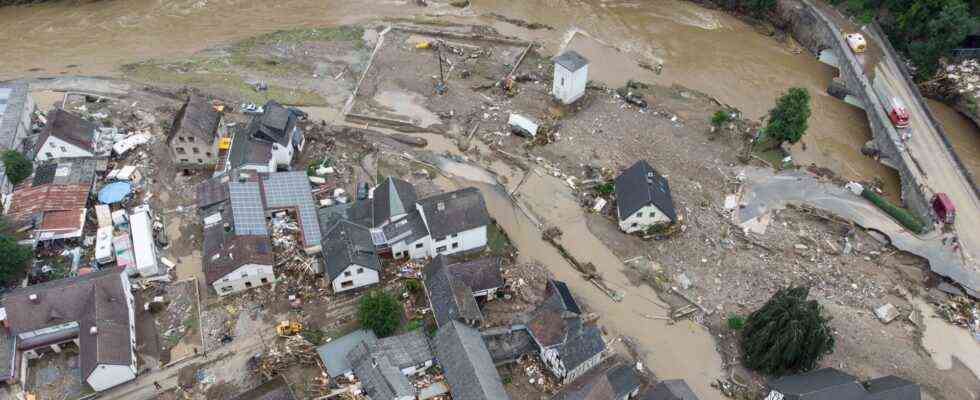interview
Status: 07/16/2021 5:13 p.m.
More early warning systems, better disaster management and the concept of the “sponge city”: How people and cities can arm themselves against extreme weather, explains hydrologist Bruno Merz in tagesschau.de-Interview.
tagesschau.de: More than 100 dead already, entire regions destroyed, how can you better prepare yourself so that such a flood disaster does not occur?
Bruno Merz: This is of course a big question that is not that easy to answer. As far as it can be estimated so far, many things have come together: Extreme heavy rain, saturated soils that could hardly absorb water and low mountain regions were also affected – the water masses then have enormous flow speeds and develop a special force.
But there are of course a whole range of approaches to better prepare yourself in advance. This applies to urban planning, general water management and flood protection. In the specific situation, it is then also about the evaluation of weather forecasts, the risk assessment and even evacuation management.
To person
Prof. Dr. Bruno Merz is head of the hydrology section at the Helmholtz Center Potsdam (German Research Center for Geosciences) and professor at the University of Potsdam. His main research interests are hydrological extreme events, risk analysis and flood risk management.
tagesschau.de: Let look at the aspect of urban planning, how can you arm yourself against extreme weather conditions?
Merz: The infrastructure in cities, especially the sewer system, is not designed for such extreme weather conditions. This is also quite deliberately so, that could not be realized at all. But there has also been a rethink in recent years.
Experts are now relying on the concept of the “sponge city”. This means that we are planning water storage in the cities – such as green roofs, more infiltration and flood areas in order to absorb heavy precipitation as well as possible. This means we are better positioned for extreme weather conditions.
tagesschau.de: In your opinion, what have been the biggest mistakes in flood protection over the past few decades?
Merz: For a long time, structural measures have been the main focus, i.e. river dikes, flood protection walls, catch basins and dams. On the one hand, this is of course very effective, but on the other hand, I think we have done too little for spatial planning. So the question of how close houses should be built to streams and rivers. And then of course the people there also have to be better informed about the risks and how to prepare for them.
Flood situation in NRW continues to be tense
Jan Koch, WDR, Tagesschau 12:00 p.m., July 16, 2021
“Such a risk cannot be factored in”
tagesschau.de: And what has gotten better in the past few years?
Merz: There has actually been a rethink, at the latest after the severe floods on the Elbe and Danube in 2002 and the floods in 2013. After that, the risk of flooding on rivers was examined for the whole of Germany and corresponding maps were created. Before that, you sometimes didn’t even know how high the local risks are.
But in recent years we have observed that there has been an increasing number of particularly heavy rain. That is then huge masses of water. And such a risk simply cannot be factored in beforehand, because it can occur anywhere. Especially since the smaller rivers and streams have not yet been recorded. And when these swell with such enormous amounts of water, then of course they can also develop a devastating force.
“Advance warning time of one hour”
tagesschau.de: But if you basically know that certain regions have a higher risk. Shouldn’t the population there also be better educated on how to behave in the event of a hazard or even a disaster?
Merz: Basically, of course, I agree with you. Many people do not know what to do in advance and especially not in such a dramatic situation. We also need to expand the early warning systems. In the specific case, however, we must first investigate why there have been so many deaths tragically.
We have had severe floods over and over again in the past few decades, but fortunately significantly fewer people were killed. And the examinations at the time showed that an early warning time of one hour was sufficient for those affected to get to safety. It is all the more necessary to analyze exactly how such a dramatic situation could come about – and what we can learn from it for the future.
tagesschau.de: What can homeowners do themselves? How can you make your own home safer?
Merz: There are a number of measures: watertight basements, specially sealed windows or water protection barriers in the garden. But of course that only helps up to a certain water level or a certain flow velocity. Homeowners cannot really arm themselves for such extreme situations, as we have seen in some parts of Rhineland-Palatinate and North Rhine-Westphalia.
“Heavy rain will continue to increase”
tagesschau.de: Thunderstorms and heavy rain have always existed, but it has gotten worse – keyword climate change. Is it to be expected that such extreme weather conditions will increase?
Merz: All of our data show that local heavy rain is more frequent and the intensity is also increasing. And our forecasts also show that these phenomena will only intensify. Accordingly, we have to make progress on climate protection.
But we also have to create concepts on how we can better prepare for such extreme weather conditions: from urban planning and early warning systems to evacuation and disaster management. But unfortunately it is also clear – there is always a residual risk.
The interview was conducted by Stefan Keilmann, tagesschau.de
Christian Hoch, WDR, describes how the people and rescue workers are doing on site
daily news 12:00 p.m., July 16, 2021

